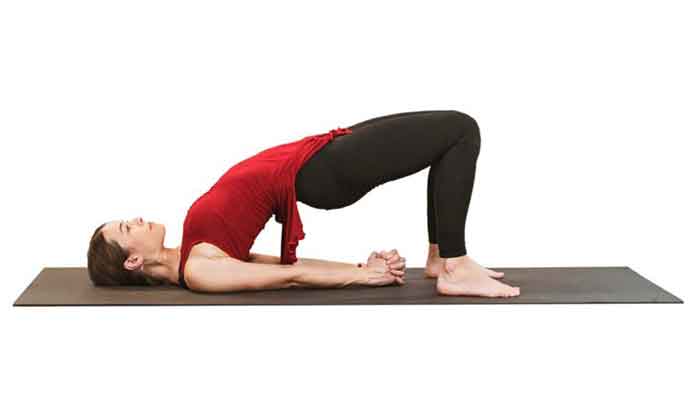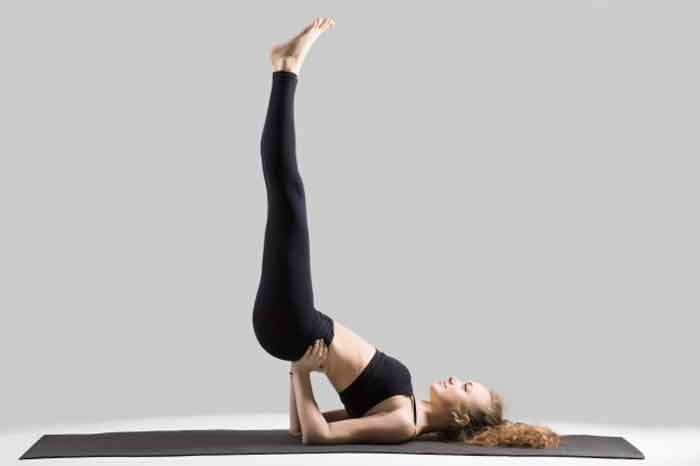Table of Contents
Great Yoga Poses to Increase Fertility in Females
Most women nowadays are having difficulty conceiving as a result of stress, which affects both their physical and mental health.
According to World Health Organization figures, roughly 15% of couples globally require assistance with infertility issues. There are a variety of treatments accessible to such couples, including fertility-boosting yoga, which is fast gaining popularity.

What Is Fertility Boosting (Increase Fertility) Yoga, Exactly?
Yoga is a 5000-year-old Indian discipline that can help you transform your mind, body, and spirit.
Fertility-enhancing yoga is a collection of specific asanas and postures that help in reducing stress levels and clearing toxins from the body. It is not a different type of yoga that can aggravate the condition of pregnancy, but it is a collection of asanas and postures that help in reducing stress levels and clearing toxins from the body.
The asanas in these yogasanas are good for women who want to get pregnant since they strengthen the body and boost the possibilities of getting pregnant.
According to a Harvard research, women who participated in fertility-specific yoga classes were more likely to conceive than women who did not.

What Are The Most Common Reasons For Infertility?
Your Age
Women’s fertility begins to drop as they get older, especially around the age of 30. This is due to the fact that a female produces all of her eggs throughout her life, beginning when she is born, and the amount and quality of these eggs decreases as she grows older.
Tobacco
Women’s fertility can be harmed by smoking, which reduces their chances of conceiving. Cigarettes contain extremely harmful chemicals that harm the reproductive system.
Liquor
Although no conclusive evidence exists regarding the effect of alcohol on fertility, numerous research conducted around the world suggest that regular alcohol drinking raises the risk of infertility.
Eating Problems
Infertility is a risk for women who have poor dietary habits and lead sedentary lifestyles. Women’s periods can be disrupted by eating disorders, which is medically recognised as amenorrhea. Fertility suffers as a result.
Damage to the Uterus or Fallopian Tubes
Chronic infection, obstruction, or any chronic disease, among other things, can harm the fallopian tubes and other key reproductive organs. Infertility results as a result of sperm not reaching the ovum or the fertilised ovum not reaching the uterus.
Tension
Overwork, family obligations, and other sources of stress have an impact on the body and can diminish the likelihood of becoming pregnant. Inability to conceive adds to the tension, creating a vicious cycle from which it is critical to break free.
Some of the factors mentioned above can be overcome with fertility boosting yoga. You can improve your health and your chances of getting pregnant by attempting yoga for infertility issues.

What Are The Benefits Of Yoga Postures For Fertility?
To improve your chances of becoming pregnant, you must have a healthy body and a peaceful mind. Yoga postures are a fantastic approach to boost fertility since they maintain your body healthy and flexible. It incorporates both physical and mental components of wellness, and some yoga postures can promote both at the same time. Using these mudras on a regular basis will help you become more fertile.
If you want to start a family, you should practise yoga. The following are some of the most notable advantages of practising yoga to help women become more fertile:
Yoga Is a Stress Reliever
Yoga breathing techniques lower stress levels and the hormone cortisol, which improves the body’s capacity to conceive and deliver a healthy baby. Stress is reduced, and the body is poison-free, resulting in a pleasant night’s sleep.
Yoga Improves Blood Circulation
Long-term diseases and other impediments to a healthy reproductive life are eliminated by yoga. By emptying out all the impurities from your blood, fertility-enhancing yoga promotes blood flow.
Blood quality is critical for conception and pregnancy since it aids in the growth of the foetus.
Yoga Aids in the Management of Hormone Imbalances
- Being unable to conceive owing to hormonal imbalance can be extremely stressful, affecting not only your physical but also your emotional health. Yoga calms the mind and balances the hormones that produce imbalance.
- Yoga is the best approach to conceive because it prevents any unwanted hormone changes that can interfere with pregnancy.
- Yoga helps to keep the ovaries healthy Ovarian dysfunction is one of the leading reasons of female infertility. Yoga is one of the greatest natural ways to cure ovulation disorders, aside from medical treatment.
- Yoga generates a great deal of positive energy in the body. Medicines used to induce pregnancy have a positive impact on a healthy body.
To Conceive and Overcome Infertility, Practise These Yoga Postures
There are different forms of yogasanas that can help you become more fertile. Regularly perform these asanas to acclimate your body:-

Bhramari Pranayama
Bhramari Pranayama is an excellent approach to relieve anxiety and tension. Because stress is a primary cause of infertility, practising Bhramari Pranayama is essential.
How to Complete It:
- Sit comfortable and close your eyes.
- Block out the noise around you by placing your index finger on the cartilage of your ear.
- Take a deep breath and exhale while humming.
- Repeat steps 5–6 as many times as you can, holding each action for as long as you can.

Paschimottanasana
An asana that strains the back is known as Paschimottanasana. The major vein muscles in your lower back, hips, and below the knees are strengthened by this asana. This asana can help women become more fertile by energising critical organs like the ovaries and abdomen while also reducing mental tension.
How to Complete It:
- Pull your toes towards you while sitting with your legs extended forward.
- Take a profound breath & raise your hands over head.
- Keep your spine straight while exhaling, then slowly bend down and touch the sides of your feet.
- Hold this position for at least 2 minutes.
- Inhale deeply and return to a sitting position by extending your arms and exhaling.
- Repeat this asana 5-6 times till you are comfortable with it.

Hastapadasana
Hastapadasana, or ‘arm and leg position,’ develops all of the muscles in your back and belly while also boosting blood flow. This yoga stance is also beneficial for keeping your body flexible and free of abdominal strain.
How to Complete It:
- Raise your hands above your head and stand up straight.
- Lean forward slowly, attempting to touch your toes with your hands. Do not do this while bending your knees. Try to bend forward as much as you can if you can’t touch your toes.
- Hold this position for a minute before slowly rising.
- Repeat this kriya 10-12 times each day; with practise, you should be able to touch your toes.

Janushirshasana
This yoga asana is beneficial not just during conception but also during pregnancy. It is one of the most common yogasanas for treating infertility, and it refers to knee and head posture. It relaxes your abdominal muscles and makes your body’s big nerves in your calves and knees more flexible.
How to Do It:
- Be seated in a contented position with your legs overextended out in front of you.
- Keep your right leg stretched in front while bending your left leg inwards. Now bend forward as far as you can to reach out and touch the right leg with your hand.
- Hold this position for 30 seconds before rising. Bend your right leg inwards and draw your other leg out to repeat the motion.
- Bend down as much as you can to touch your left leg, hold this position for a few moments, then stand to finish the process.
- Repeat steps 1-4 for a total of 4-5 times.

Baddhakonasana
Butterfly position is also known as Baddhakonasana. The muscles of your inner thighs, genitals, hip area, and knees become more flexible as a result. It is one of the more assisted reproductive power yoga movements, and it aids in a smoother and less painful delivery when the time comes.
How to Complete It:
- Sit comfortably with your back straight and your legs spread out in front of you.
- Invert the feet such that the soles of the feet face each other.
- Pull your feet as close to your pelvic area as possible by holding them together.
- With your feet firmly planted, move your thighs up and down like butterfly wings.
- Do this asana as often as possible. It is recommended that you practise it 5-10 times per day.

Supta Baddhakonasana
The inner thigh and waist muscles are strengthened in this yoga pose. Menstrual cramps, bloating, and stress can all be relieved by Supta Baddhakonasana.
How to Complete It:
- Lie flat on your back on the floor, using a pillow to support your neck if necessary.
- Place both palms on your sides, palms facing upwards.
- Bend your knees upwards while keeping your soles on the floor.
- Keep your knees straight to the side and your toes separate from one another.
- Hold for 7-8 minutes in this asana.

Balasan
Balasana relieves stress and improves blood flow, both of which are beneficial to conception. This yoga pose extends your back, knees, hips, and thighs muscles. Before executing this asana, make sure your stomach is empty, therefore practise yoga at least four to six hours after eating.
How to Complete It:
- Sit on your heels and kneel on the floor. Check to see if your toes are connected together.
- Bend forward slowly, spreading your knees to the level of your hips.
- Extend your hands in front of you and place them there.
- Stay in this posture as long as you can, breathing normally.

Pranayama Kapalbhati
‘Kapalbhati’ is a prominent yoga asana that acts as a preventative for a variety of ailments. It keeps you energised so that your stress level is low and you maintain a happy mood at all times.
How to Complete It:
- Be seated in a contented position with your eyes shut and your backbone straightforward.
- Inhale deeply through your nose and aggressively exhale such that your belly button moves in.
- Hold this asana for 5 minutes and notice the difference in your mind and body.

Sarvangasana
Sarvangasana, when performed with the shoulders supported, aids in the treatment of thyroid issues and lowers stress. Because it directly affects the thyroid gland, this asana is one of the most efficient fertility promoting yoga asanas.
Thyroid issues are a common cause of infertility in women, and thyroid-stimulating hormone (TSH) deficiency can cause a variety of health problems, including infertility.
How to Complete It:
- Lie down on your back with your legs straightened.
- Raise your legs to 90 degrees and raise your waist and legs with your palms.
- Hold this position for 50-100 seconds.
- Repeat this method 5–10 times, depending on how comfortable you are with it.

Setu Bandhasana
The body takes on the shape of a bridge or a bridge in this position. It relaxes the brain and central nervous system while also increasing blood flow throughout the body.
How to Complete It:
- Wrap both hands straight on one side while lying on your back.
- Bend your knees slowly and keep your feet in a position where they are in contact with the floor.
- Lift the pelvic region upwards with the help of your hands and feet on the ground.
- Hold this position for at least 10-15 seconds.

Bhujangasana
Bhujangasana resembles a cobra’s position. It enhances blood flow while increasing flexibility, contouring the abdomen, strengthening the back and shoulders, and contouring the abdomen.
How to Complete It:
- Lie even on your belly on the ground.
- Keep your hands by your sides and your feet close together.
- Inhale deeply and lift your upper body off the ground, pushing it back and stretching it.
- Slowly exhale and return to your original position.

Viparita-Karni
Viparita-karani asana is thought to offer anti-aging properties and enhance blood flow to the pelvic region. After intercourse, resting in this position might dramatically boost your chances of conception.
How to Complete It:
- Take a deep breath and lie down on your back.
- Raise your legs slowly to a 90-degree angle and hold this position for as long as possible.
- Perform the asana 5–8 times more.

Pranayama Nadi Shodhana
This yoga movement, also recognised as Anulom-Vilom or Nasal Alternation Breathing, keeps your body free of evil emotions, anxiety, stress, and concern.
How to Complete It:
- Sit with your spine straight and in a comfortable position.
- Place your right hand’s thumb on the right side of your nose and inhale through the left side.
- Exhale through the right side of your nose while placing your left thumb on the left side of your nose.
- Repeat for a total of 5 minutes.

Upavistha Konasana
Upavishta Konasana is one such yogasana that aids in fertility enhancement. It calms the mind and body while strengthening the abdominal region, thighs, and spine.
How to Complete It:
- Sit in a comfortable position with your legs at a 90-degree angle to each other.
- Take a deep breath and bend forward as far as you can.
- Hold this position for one minute.
- Take a deep breath and stand up.
- Repeat the method five times more.

Salamba Shirshasan
Salamba Shirshasana, which is performed with the help of the hands, is one of the most difficult but also one of the most effective yogasanas for improving fertility.
How to Complete It:
- Make your bed with a nice mattress or pillow.
- Place your head between your hands on the ground.
- Try to balance your body weight by straightening your legs and putting your weight on your head and hands.
- Hold the stance for as long as you can while maintaining normal breathing.

Shavasana
Because of its simplicity, this yoga asana is quite popular. The state of the dead body or dead body is the inspiration for this yoga position. This is done to promote relaxation at the end of a full yoga session.
How to Complete It:
- Lie down on the ground with both hands straight out to the edge.
- Take a few minutes to relax and breathe properly.
Also Watch: Morning Mantras | Morning Chants
Yoga might assist you in taking a more holistic approach to infertility therapy. However, it is recommended that you use it only in conjunction with a doctor’s accurate diagnosis and treatment. Once the problem has been identified and a treatment plan has been recommended, you will soon be able to welcome that long-awaited new family member.